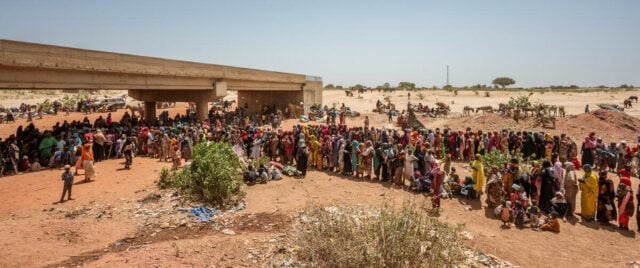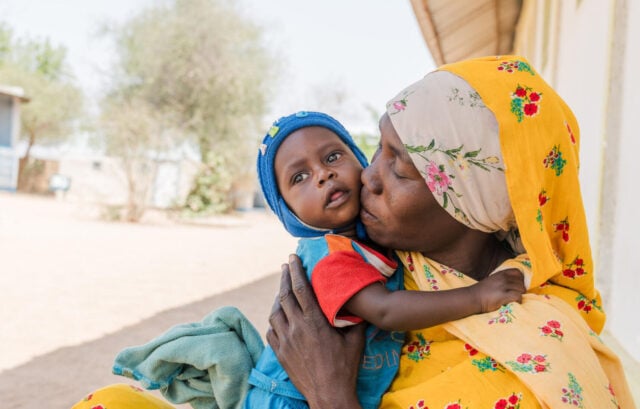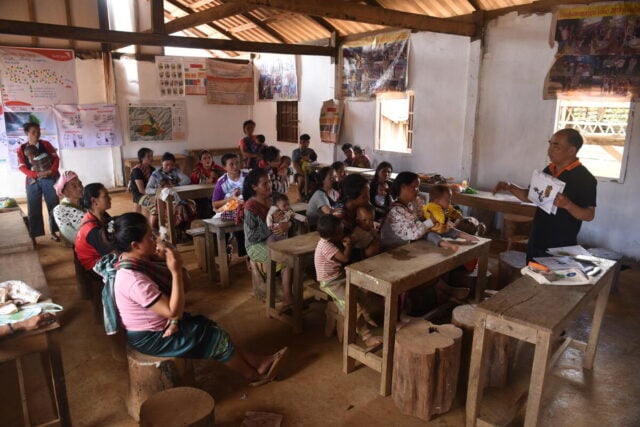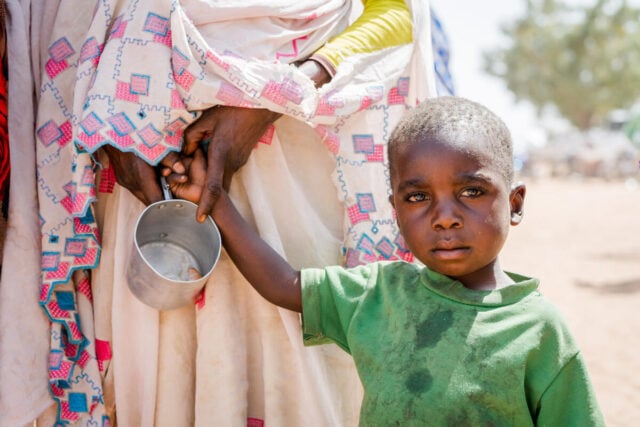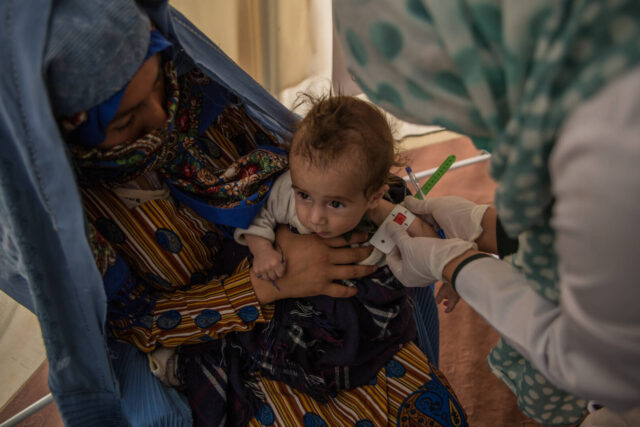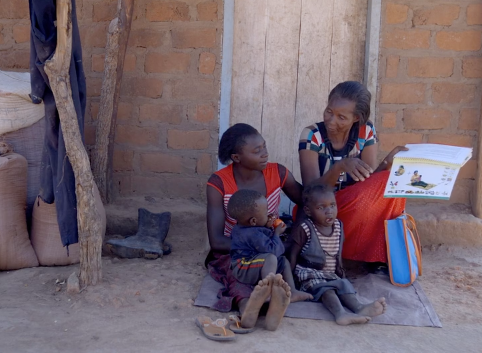
Hunger and food security
Nearly 35 million people in 39 countries are facing emergency levels of hunger due to conflicts, rising costs, extreme weather events, and more. 45 million children are dangerously malnourished.
World Vision partners with communities to address immediate food needs — and also to ensure vulnerable communities and families are better equipped and more resilient for the future.
Over the last 10 years, 89% of the severely malnourished children we treated made a full recovery.
From March 2021 to August 2024, we reached 38.4 million people with critical food and aid in response to the global hunger crisis.
Thanks to the support of World Vision donors around the world.
We’re responding in 31 of the countries that are hardest-hit by the global hunger crisis.
We work in 40 of the 60 countries classified by global experts as “fragile” and especially susceptible to hunger.
Our deep relationships with USAID as well as partnerships at country and local levels enable us to reach the most remote locations and serve the people in greatest need.
Our approach to overcoming hunger
What is World Vision doing to address hunger around the world?
In April 2022 we launched our largest humanitarian undertaking ever in response to the global hunger crisis. Our 18-month response is focused on delivering life-saving aid to 22 million people in 26 countries where hunger is at its worst.
We work to equip children and families with the means to overcome hunger and achieve food security, which means they know where their next meal is coming from — and that it will be enough nutritious food to live an active, healthy life.
Specifically, we help hungry children and families by:
- Delivering emergency food aid during crises
- Increasing agricultural productivity through improved seeds and farming practices
- Improving access to markets so farming families can profitably sell their surplus food
- Teaching families and communities how to improve nutrition and dietary diversity
- Managing resources in a sustainable way to prevent soil erosion, maintain soil fertility, use water more efficiently, and protect the environment
How does World Vision help families grow their own food more sustainably?
We help farmers increase their productivity by:
- Helping them get improved, locally adapted seeds and tools and sustainable access to clean water
- Teaching more productive agricultural practices such as promoting diversified and integrated farming systems, including livestock
- Training families about better post-harvest storage and processing techniques to ensure more food is preserved and less is wasted
- Bringing farmers together in associations and cooperatives, so they have more bargaining power and better access to markets and business development services, including credit, allowing them to graduate from subsistence to commercial farming
What if there’s a famine? Do you distribute aid?
We deliver emergency food aid to make sure children and families get essential nutrients during times of acute crisis. At the same time, we help families strengthen and improve their ability to produce or purchase their own food. This approach helps families become more resilient and better equipped to handle future food challenges.
How does teaching families and communities about nutrition help?
Rural families often grow or raise their own food. They may rely on crops and animals that grow locally, as well as traditional recipes that may not create balanced nutritional meals. We train volunteers to help families and communities learn about nutritious, appropriate crops to grow; small animals that are easy to raise; new recipes; and how to cook variations on local recipes in order to provide more nutritious meals.
We focus on ensuring nutrition for pregnant and lactating mothers, as well as mothers of children under the age of 5, who are most vulnerable to the long-term impacts of malnutrition. Mothers also learn to recognize signs of malnourishment among their children, and what to do if they detect it.
As a result of these programs, children and families are healthier, have more energy, and get sick less often.
Food and agriculture resources
Mainstreaming Nutrition Within Food Systems
World Vision co-authored this series of technical publications on maximizing nutrition outcomes within food systems.
Building Community Resilience to Climate Shocks
Resilience strategies underpin the work of many agencies working in complex, fragile environments. This case study describes the experience of World Vision’s USAID project in Zimbabwe on the matter.
Farming as a Business (FAAB) Manual for Smallholder Farmers
The USAID-funded ENSURE project in Zimbabwe developed this manual to promote farming as a viable and sustainable business.
We’re responding in 31 of the countries that are hardest-hit by the global hunger crisis.
We work in 40 of the 60 countries classified by global experts as “fragile” and especially susceptible to hunger.
Our deep relationships with USAID as well as partnerships at country and local levels enable us to reach the most remote locations and serve the people in greatest need.
Our approach to overcoming hunger
What is World Vision doing to address hunger around the world?
In April 2022 we launched our largest humanitarian undertaking ever in response to the global hunger crisis. Our 18-month response is focused on delivering life-saving aid to 22 million people in 26 countries where hunger is at its worst.
We work to equip children and families with the means to overcome hunger and achieve food security, which means they know where their next meal is coming from — and that it will be enough nutritious food to live an active, healthy life.
Specifically, we help hungry children and families by:
- Delivering emergency food aid during crises
- Increasing agricultural productivity through improved seeds and farming practices
- Improving access to markets so farming families can profitably sell their surplus food
- Teaching families and communities how to improve nutrition and dietary diversity
- Managing resources in a sustainable way to prevent soil erosion, maintain soil fertility, use water more efficiently, and protect the environment
How does World Vision help families grow their own food more sustainably?
We help farmers increase their productivity by:
- Helping them get improved, locally adapted seeds and tools and sustainable access to clean water
- Teaching more productive agricultural practices such as promoting diversified and integrated farming systems, including livestock
- Training families about better post-harvest storage and processing techniques to ensure more food is preserved and less is wasted
- Bringing farmers together in associations and cooperatives, so they have more bargaining power and better access to markets and business development services, including credit, allowing them to graduate from subsistence to commercial farming
What if there’s a famine? Do you distribute aid?
We deliver emergency food aid to make sure children and families get essential nutrients during times of acute crisis. At the same time, we help families strengthen and improve their ability to produce or purchase their own food. This approach helps families become more resilient and better equipped to handle future food challenges.
How does teaching families and communities about nutrition help?
Rural families often grow or raise their own food. They may rely on crops and animals that grow locally, as well as traditional recipes that may not create balanced nutritional meals. We train volunteers to help families and communities learn about nutritious, appropriate crops to grow; small animals that are easy to raise; new recipes; and how to cook variations on local recipes in order to provide more nutritious meals.
We focus on ensuring nutrition for pregnant and lactating mothers, as well as mothers of children under the age of 5, who are most vulnerable to the long-term impacts of malnutrition. Mothers also learn to recognize signs of malnourishment among their children, and what to do if they detect it.
As a result of these programs, children and families are healthier, have more energy, and get sick less often.
Resource Archives:
- Africa’s Agricultural Potential: This infographic shows how Africa can address hunger and malnutrition while boosting livelihoods and promoting inclusive, sustainable growth.
-
Ultra Rice® test: World Vision and PATH conducted a field trial to test Ultra Rice® grains, generating data on its stability under real world transport and storage conditions, and the health impact (PDF) among African children.
Food and agriculture resources
Building Community Resilience to Climate Shocks
Resilience strategies underpin the work of many agencies working in complex, fragile environments. This case study describes the experience of World Vision’s USAID project in Zimbabwe on the matter.
Farming as a Business (FAAB) Manual for Smallholder Farmers
The USAID-funded ENSURE project in Zimbabwe developed this manual to promote farming as a viable and sustainable business.
Ways to support hunger relief and food security
Hunger Relief Fund
When you donate to the Hunger Relief Fund, you help feed hungry children and families around the world. No child should lack nutritious food, but 45 million children worldwide are dangerously malnourished — suffering from acute malnutrition or “wasting.” Children with this condition are at higher risk of dying from common childhood diseases due to weakened immune systems, and those who survive can be impacted by permanent growth and development challenges.
You can help ensure kids get the nutrition they need, addressing immediate food needs and empowering families to grow their own sustainable sources of food. And thanks to public grants, your gift will multiply 12 times in impact!
Hunger Relief Partner
When you become a monthly donor to the Hunger Relief Fund, you provide consistent, life-saving nutrition to children suffering from acute malnutrition. No child should lack nutritious food, but 45 million children worldwide are dangerously malnourished — suffering from acute malnutrition or “wasting.” Children with this condition are at higher risk of dying from common childhood diseases due to weakened immune systems, and those who survive can be impacted by permanent growth and development challenges.
Monthly giving is the most effective way to help children and families who need it most. Plus, it lowers costs, which means more of your gift helps kids! And thanks to public grants, your gift will multiply 12 times in impact!
Ways to support hunger relief and food security
Hunger Relief Fund
When you donate to the Hunger Relief Fund, you help feed hungry children and families around the world. No child should lack nutritious food, but 45 million children worldwide are dangerously malnourished — suffering from acute malnutrition or “wasting.” Children with this condition are at higher risk of dying from common childhood diseases due to weakened immune systems, and those who survive can be impacted by permanent growth and development challenges.
You can help ensure kids get the nutrition they need, addressing immediate food needs and empowering families to grow their own sustainable sources of food. And thanks to public grants, your gift will multiply 12 times in impact!
Become a Hunger Relief Partner
When you donate to the Hunger Relief Fund, you can help stop hunger for children and families around the world. No child should lack nutritious food, but 233.5 million children were malnourished in 2020, without considering the impact of the COVID-19 pandemic.
You can help ensure kids get the nutrition they need, addressing immediate food needs and empowering families to grow their own sustainable sources of food. And thanks to public grants, your gifts will multiply 15 times in impact!
Monthly giving is the most effective way to help children and families who need it most. Plus, it lowers costs, which means more of your gift helps kids!

